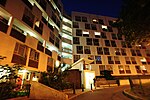Riceyman Steps
1923 British novelsFiction set in 1919Fiction set in 1920Novels by Arnold BennettNovels set in London

Riceyman Steps is a novel by British novelist Arnold Bennett, first published in 1923 and winner of that year's James Tait Black Memorial Prize for fiction. It follows a year in the life of Henry Earlforward, a miserly second-hand bookshop owner in the Clerkenwell area of London.
Excerpt from the Wikipedia article Riceyman Steps (License: CC BY-SA 3.0, Authors, Images).Riceyman Steps
King's Cross Road, London Clerkenwell (London Borough of Islington)
Geographical coordinates (GPS) Address Website Nearby Places Show on map
Geographical coordinates (GPS)
| Latitude | Longitude |
|---|---|
| N 51.527222222222 ° | E -0.11388888888889 ° |
Address
Travelodge (Travelodge London Farringdon)
King's Cross Road 10-42
WC1X 9QE London, Clerkenwell (London Borough of Islington)
England, United Kingdom
Open on Google Maps











